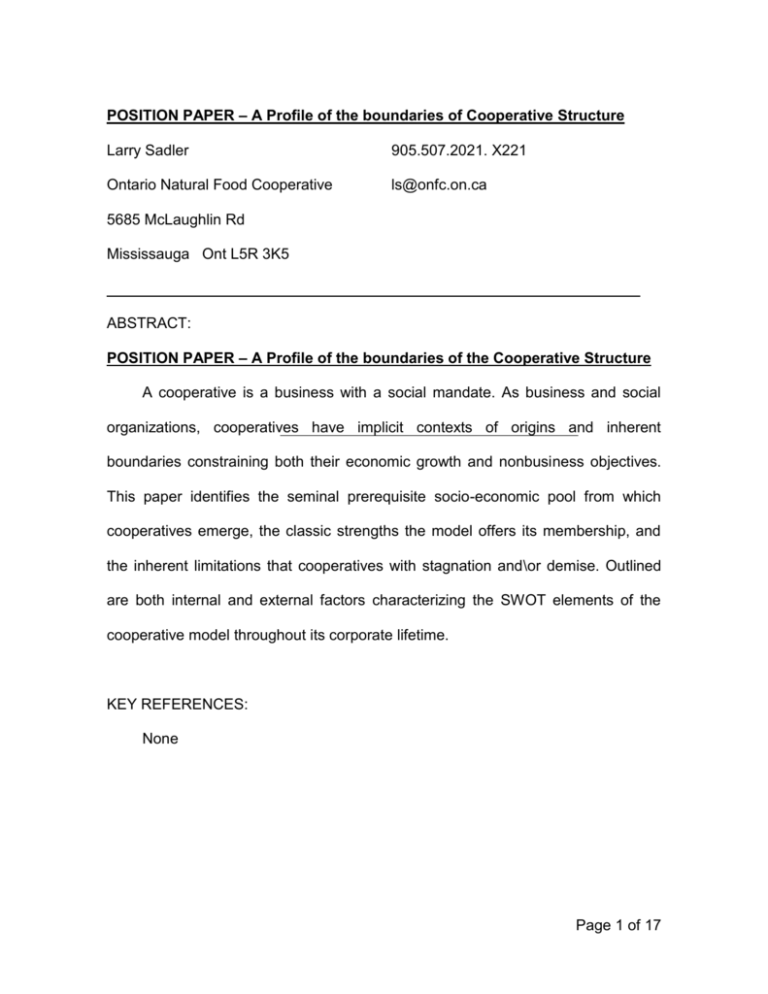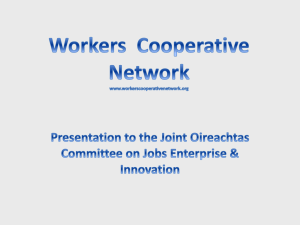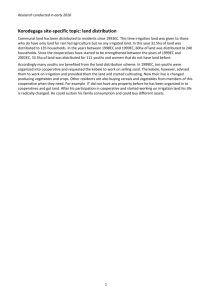Table 1: Topical boundaries of cooperatives
advertisement

POSITION PAPER – A Profile of the boundaries of Cooperative Structure Larry Sadler 905.507.2021. X221 Ontario Natural Food Cooperative ls@onfc.on.ca 5685 McLaughlin Rd Mississauga Ont L5R 3K5 ABSTRACT: POSITION PAPER – A Profile of the boundaries of the Cooperative Structure A cooperative is a business with a social mandate. As business and social organizations, cooperatives have implicit contexts of origins and inherent boundaries constraining both their economic growth and nonbusiness objectives. This paper identifies the seminal prerequisite socio-economic pool from which cooperatives emerge, the classic strengths the model offers its membership, and the inherent limitations that cooperatives with stagnation and\or demise. Outlined are both internal and external factors characterizing the SWOT elements of the cooperative model throughout its corporate lifetime. KEY REFERENCES: None Page 1 of 17 1 MAY 2009 POSITION PAPER – A Profile of the boundaries of Cooperative Structure Larry Sadler ls@onfc.on.ca 905.507.2021 x221 Ontario Natural Food Cooperative 5685 McLaughlin Rd, Mississauga, Ontario, L5R 3K5 Introduction The general conclusion by critics is that cooperatives are neither suitable for, nor of interest to, all socio-economic strata. There are social and economic circumstances and advantages where cooperatives emerge and flourish. Similarly there are boundary conditions that constrain their ultimate growth potential and threaten their demise. Cooperatives, like all organizational forms, have structural minimum and maximum thresholds. This reality is not an indictment of cooperatives. When one examines the life of individual conventional corporations and organizations, very few last a very long time. Consider forms of government [royalty, feudal, dictatorial], religious philosophies [polytheism, monotheism, atheism], and business types. These macro organizations are relatively new in terms of human history. Very few of the companies listed on the major stock exchanges of the world, for example in 1900, remain intact today. In the US, about one million companies are formed each year; and about one million companies go bankrupt each year1. Of the million companies formed in the US in a given year, only about four will become industry leaders2. 1 Lester Thurow, TV appearance, c 2002 2 ibid Page 2 of 17 As an organizational structure, cooperatives have been successful and sustainable garnering over a billion members world wide in just a century and half. In the US about 50% of the population is associated with a cooperative. In Canada about 33% of the population is a Member of a cooperative or credit union. Fundamentally, limits to growth are an environmental constraint for every ecology – physical, political, social, and economic. Many publications address the task of answering the question “What is a cooperative?” This paper addresses the question in general terms by describing conceptual and operational boundaries of cooperatives. Business spectrum Structure - context The spectrum of business ownership\control ranges from individual based sole proprietorship businesses, through group organizations, to large anonymous multinational corporations. The two ends of the business spectrum - individual and disbursed corporate ownership - have the inherent structure of unilateral decision making by a single individual or an exclusive oligarchy. In contrast, the structural design of interval group based organizations – and thereby cooperatives - is premised on group ownership and group control thus reducing the risk of arbitrary and self serving actions by individuals or oligarchies that operate to the detriment of the interests of the other stakeholders participating in the organization. Group structures include various social, religious, political, and mutual support based organizations. Cooperatives are, in western economies, a formal variant of the group organization. The simplest characterization of Page 3 of 17 cooperatives is collective action among a group of people sharing a common goal. The model presumes they embrace a common philosophy of shared responsibility and control .The following table and discussion describes four boundary conditions characteristic of cooperatives. Table 1: Topical boundaries of cooperatives Topic +ve attribute -ve attribute Middle class Dependent on middle class Pendulum of wealth Pendulum of wealth Feedback & loyalty Limited involvement Social relevance Personal relevance Personal growth Participation rate Democratic Democratic Leadership Leadership Governance Capitalization A lot from a little To little from to few Page 4 of 17 Social relevance – class structure On the spectrum of economic class, the low income segment of the population does not have either the pool of available skills or investment resources to begin or to operate a cooperative business. In the high income segment, there is neither a pressing need to consolidate skills nor to pool financial resources, as well as a culture of class independence. Thus the cooperative model is centred on the middle class for membership and more so on leadership. Even where the cooperative model has flourished in specific low income settings – eg micro loans in the third world – the phenomenon began with and is nourished by middle class skills3 . It must be acknowledged that the cooperative model provides an incubation environment through which the required skills can be nurtured and developed. Social relevance – pendulum of wealth The classic circumstances that give rise to cooperative organizations are a broad based economic need not otherwise satisfied by either individual entrepreneurship nor the established corporate structure nor public services. Credit Unions in small communities are a prime example. As a community becomes financially more successful, two factors begin to erode the cooperative structure: increasing wealth leads to deteriorating interest in shared involvement and a growing interest in a wider variety of selection of goods and services resulting in waning loyalty to the community organization. The risk of this pattern exists in both consumer and producer cooperatives. This is the wealth pendulum: less wealth fosters cooperatives; more wealth dilutes cooperatives. 3 Muhammad Yunus, economist, Nobel Prize winner, National Geographic News, 13 OCT Page 5 of 17 Personal relevance – feedback and loyalty: +ve Like all group organizations, cooperatives provide two dimensions of personal involvement to the constituency that neither individual nor diverse organizations often achieve – feedback and loyalty. While feedback is not exclusive to any organizational structure, group organizations like cooperatives typically have the benefit of a high degree of involvement by their constituency – notwithstanding that maintaining that involvement is a chronic challenge. The two prime measures of involvement are level of direct feedback from the constituency and patronage loyalty to the organization. The sense of ownership by cooperative Members is manifested many times by the initiative that Members demonstrate to their cooperative. This may be the prolific opinions expressed directly to staff or to Board Members regarding every day issues or in the loyalty expressed by the “coop first” buying decisions in spite of the enticements around them from the private sector. Personal relevance – limited involvement: -ve As cooperatives grow in membership numbers, the percentage participation in the democratic process typically falls. In part, this is often due to the logistics of meeting times and places. In part, the trend is due to the confidence – justified or not - that the involvement responsibilities will be address by others. In part, there is an intimidation factor as numbers grow. In part, there is an alienation of intimacy for those who's sense of community relates to the smaller membership numbers of the “old days”. 2006 Page 6 of 17 Multifunction cooperatives also have a very practical structural quandary. As diversification evolves and the membership numbers grow, the skill set to lead and operate an increasingly complex organization demands higher levels of management skills. Alternatively, multiple functions can be accommodated by the creation of multiple single function organizations serving essentially the same community. This alternate organizational structure creates the demand for a multiplicity of governance and leadership drawn from the same constituency. Thus significant growth presents individual members with two unpleasant alternatives either the alienation of a complex and increasingly “professional” business or the multiplicity of demands of involvement in a multiplicity of separate organizations. Either avenue leads to severe member relations challenges. Growth in the numbers in the membership and staff invites a dilution effect. Broadening the membership base typically attracts new Members primarily in terms of the coop’s economic benefits. This minimizes the social and ownership\responsibility aspects. Similarly, when growth demands significant increases in staff, especially skilled staff, the risk of hiring criteria emphasising the skill set vs the philosophical congruence with cooperative philosophy and values rises. This puts an increasing burden on the coop's organizational culture to absorb and educate new staff who don't come with an affinity with the social values of the coop – “It's just a job; not a commitment”. Personal relevance – personal growth: +ve Cooperatives structurally solicit and foster the scope of opportunity for personal growth from its constituency that neither private nor public shareholder Page 7 of 17 organizations offer. There are many roles in the cooperative organization that are given preference to, and often reserved for, the membership. Examples are committee participation, Board participation, training experiences, and responsive business policies and practices. Page 8 of 17 Personal relevance – Participation rate: -ve The complex impact of the Pendulum of wealth, the alienation arising from “too much” growth, the constant demands on the “coop keeners” to do more and more, and the risk of the insidious slide to a purely economic relationship between the cooperative and the Members results in a declining proportion of participation rate. Proxy voting, electronic voting, and the infusion of both members and management not coming from either a cooperative history or do coming specifically from a “conventional” history all work to dilute member participation. One measure of this trend is the pattern of bylaw amendments driving down the definition of the percentage of Members required for quorum at a General Members Meeting and the profusion of “gimmicks” initiated by cooperatives to entice Member participation in a stripped down agenda for those meetings. As well meaning as they are, these techniques are a measure of the decay of Membership participation which eventually leads to vulnerability in Membership loyalty. Governance – Democratic: +ve Group interest is premised on group control, and group control implies the democratic process. The Cooperative Principle of Democratic control and the statutory structural element of One Member, One Vote, solidify the democratic process inviting, without demanding, participation from all stakeholders. This process also provides the ongoing opportunity for individual self development in arenas not generally accessible to Members outside the cooperative. Examples include experience and\or training in legal, financial, and operations as well as some occasions for travel otherwise not available. Page 9 of 17 Governance - Democratic -ve Democratic control of any organization, is premised on an informed and involved constituency choosing representatives with integrity. Statistically, this premise is only partially valid – since not all representatives, elected or appointed, act with competence and\or integrity. Governance – Leadership: +ve Cooperative leadership has two basic merits: direct linkage to the user base and the opportunity for individuals to gain a corporate experience that they are unlikely to find elsewhere. It is a measure of the coop advantage by the long term commitment of ordinary individuals to the volunteer roles typical of the average cooperative. It is also a measure of success of the model that the degree of flow – constant or not so constant – of new blood emerges from the membership to fill vacancies as they appear in the various roles needed by the organization. Governance – Leadership: -ve Similarly, two structural deficits exist in the coop model: limitations of skills sets and stagnation of participants in a changing environment. The cooperative model includes the notion that the skill set required to appropriately govern and\or operate the organization exists within the constituency. This concept is also only partially valid. A prime area where skills are weakest is in the planning process, particularly strategic planning. The constituency pool for leadership typically does not have the benefit of prior experience or training around this skill set. Some cooperatives suffer from the calcification of leadership as manifested in the same people running for the same Page 10 of 17 positions year after year and not being reinvigorated with new blood. These coops do not have any structural device such as a Bylaw or a policy to enforce new thinking into the leadership forum. Capitalization – a lot Raising investment capital is a chronic problem for the small business owner. Particularly when they are small, cooperatives also experience problems raising capital. However, the collective ability to raise at least the minimum investment from a large enough collective constituency gives the cooperative structure a significant advantage relative to the individual business owner. The cooperatives with the soundest financial base choose to have a continuous investment policy. Van City Credit Union is an example of the success of a continuous Member Investment Policy. Capitalization – a little Positive growth, negative growth, and stasis are the three big strategic issues all organizations face. All three situations present complications for raising capital. When a cooperative has an opportunity to expand significantly and demands significant capital investment, the scale of Member Investment required eventually becomes a threshold that the collective membership cannot achieve either literally or psychologically. This problem applies to the individually owned business also and is the fundamental basis of the public share structures that the large businesses employ. A cooperative in contraction raises doubts about its economic viability and the raises the risk assessment of Member investment - be it debt or equity – in the Page 11 of 17 coop. Creditors and banking sources are just as concerned. A cooperative in stasis raises the question of why a proposed new investment is justified and is a much harder “sell” to rationalize pulling itself up by its bootstraps. The general situation The following graph is a macro first approximation of the relative strength of the western private enterprise sector and the cooperative sector. The graph is both an intuitive and a statistical statement; not an absolute statement. There are specific examples where individual comparisons would illustrate the opposite conclusion. Page 12 of 17 Table 2: Comparative advantage between conventional and cooperative sectors Sector Business Social acumen responsibility Conventional business Cooperative business 100% Business advantage 100% 0% Coop advantage Table 2 illustrates, qualitatively, the comparative advantage of the conventional business sector over the cooperative sector with regard to business skills and social responsibility. The graph highlights the conventional wisdom of the merits of the capitalist model vs the presumed demerits of the “socialist” model of cooperatives .The singular profit motive of conventional business gives them a demonstrable edge in business skills vs the dual focus of business operations and social responsibility that cooperatives bring to their enterprise. This is measured by the proportionate share of the cooperative sector of the GDP of a given economy vs the private sector. The two sectors share the same population, yet one commands the dominates share of GDP and, typically, the political power within the same population. Page 13 of 17 Table 3: Similarities and differences between Cooperatives and Conventional corporations Differences Policy Similarities Operations Aspect s Paramet ers Cooperat ives Asset s Liabilit ies Cust omers Administ rat ion Net Income Taxes Reinvest ment Ret urn t o Proport ional t o ow ners pat ronage One Member; Cont rol One Vot e Philosophy Optimize price to optimize Net Income Convent ionals Proport ional t o ow nership Proport ional t o ow nership Optimize price to maximize Net Income In Table 3: Similarities and differences between Cooperatives and Conventional corporations, the “” symbol identifies the operational aspects that Cooperatives and Conventional corporations have in common although typically not necessarily of equal measure. It is the policy area that cooperatives have fundamental differences with their conventional competitors. For cooperatives, the Return to Owners is premised on the allocation based on patronage that differs between consumer and producer coops. Consumer coops use sales to members [units of output] as the base. Producer coops use physical units – eg kilograms of pork - [units of input] as the base. In neither case, is investment dollars used. In contrast, conventional corporations use invested units [typically number of shares rather than number of dollars] as the basis of their distribution of surplus [usually referred to as Return on Investment]. Notwithstanding this historical [and Page 14 of 17 existing] distribution methodology, share based cooperatives have distributed surplus proportional to investment through a variety of mechanisms. In a [pure] consumer coop, the customers and the owners are the same individuals. Therefore the philosophy of pricing is, in theory, to optimize the sustainability of the cooperative thereby yielding a continuous advantageous value proposition to the Members. In contrast to a conventional corporation, the customers and owners have opposing interests. The philosophy of pricing is to maximize price and minimize costs in order to maximize Net Income in order to maximize the Return on Investment for the shareholders. In the producer coop, customers and owners are distinct and the coop's interests are much more aligned with conventional corporations – notwithstanding the control structure and Cooperative Principles in common with consumer cooperatives. In both consumer and producer coops, financing methods follow the share model and provide for financing structures much closer in style and substance to the conventional corporate model, This results in a blurring of the above distinctions and sometimes leads to a conflict of philosophies within and\or between the membership(s) of cooperatives. Page 15 of 17 A modern viable successful cooperative has the following four corporate goals: short term survivability long term sustainability social responsibility environmental respectability Macro economic influences In addition to the local boundaries discussed above, macro economic policies of governments also influence the growth or the decline of the cooperative sector. For example, in the 1960's and 1970's the cooperative sector in England handled 25% of the nation's GDP and in Sweden the sector handled 40% of GDP. Coincident with the decline of Keynsian and Neo-Keynsian paradigms in the western economies and the emergence of supply side economics [Thatcher in England; Regan in the US] the share of GDP carried by the cooperative sector declined. Some of this was due to the demise of previous government support programs and the paradigm of tax relief supplanting program support as national policy. Some of the pattern was due to the failure of the cooperative sector's leadership to adapt to the changing political\economic climate coupled with the effect of the wealth pendulum. Page 16 of 17 Summation Conceptually there are no limits to what either the coop sector can do or should do as viable economic entity. A stellar example is the Rochdale Pioneers who expanded their small store on Toad Lane to diversify laterally into multiple stores and integrated backwards into grist mills. The timing was propitious as it was coincident with the economic boom of the industrial revolution. However, the structural boundaries described above, particularly middle class characteristic and the skill pool implicit in membership, have appeared to a greater or lesser degree in each cooperative history. While grappling with these boundaries is frustrating, the philosophical question of whether cooperatives can or should push those constraints aside at what cost to the seven principles is something yet to be resolved. Page 17 of 17






